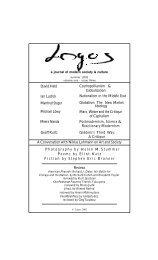Michael J. Thompson Stephen Eric Bronner Wadood Hamad - Logos
Michael J. Thompson Stephen Eric Bronner Wadood Hamad - Logos
Michael J. Thompson Stephen Eric Bronner Wadood Hamad - Logos
Create successful ePaper yourself
Turn your PDF publications into a flip-book with our unique Google optimized e-Paper software.
Ali Hossaini<br />
distance. Some claim that perspective is simply a Western convention for<br />
representation, though such arguments are difficult to maintain against<br />
optics. The dawn of the digital era has added a twist to writing on<br />
photography, giving a new generation of scholars the opportunity to decry a<br />
post-objective era.<br />
Current scholarship on photography is fragmented because it possesses no<br />
disciplinary paradigm. Beyond an unproductive dichotomy between realism<br />
and conventionalism, and an often-blurry technical history, we have no<br />
concrete understanding of how photography emerged, let alone how it<br />
engages the social mechanism. What forces gave impulse to the camera and<br />
its trajectory of development? While Bazin painfully emphasizes the objective<br />
realism of photography, and derails further study, he points to a generative<br />
function within the medium. The photographic image is not just an ersatz<br />
representation. It reproduces the environment, the thing itself, and becomes<br />
an ideal (or virtual) reality for the viewer. Bazin introduces photography with<br />
a discussion of cave paintings and Egyptian mummification. These practices,<br />
he claims, reveal the primal motives of artistic representation. He justifies this<br />
strange comparison by claiming our ancestors sought to overcome space and<br />
time by preserving appearances. In other words, to control life by<br />
constructing an idealized, artificial environment. Though concerned at this<br />
point with the plastic arts, from an historical perspective Bazin has<br />
approached the crux of photography and the technologies supporting it.<br />
While the comparison of mummies to photographs may stretch our powers<br />
of analysis, we can find other representational practices in ancient cultures<br />
which do not.<br />
Land surveying has been a profession for over six thousand years. First<br />
invented in Sumer and spreading quickly to Egypt, it emerged as one of the<br />
essential technologies of civilization, and it underlies virtually every advance<br />
in urban culture, technical representation and mass communication. It is a<br />
critical form of organized perception, but its contributions to society are<br />
often overlooked. Neither cities nor social hierarchies could exist without<br />
surveyors and the property boundaries they create. Estates, buildings, roads,<br />
and aqueducts all depend on the related acts of surveying, planning and<br />
impressing new designs into the earth.<br />
Bazin described mummification as a primal impulse behind photography,<br />
but study of surveying provides far more insight. Beyond the fact that optics<br />
derived from geometric investigation, surveying also plays the preservative<br />
<strong>Logos</strong> 2.3 – Summer 2003




